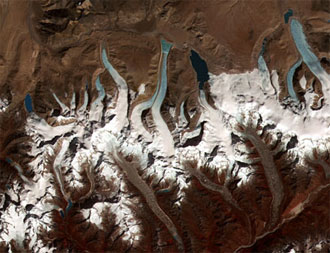China’s glaciers shrinking by 7 percent per year
mongabay.com
May 2, 2006
The glaciers of China’s Qinghai-Tibet plateau are shrinking by 7 percent a year due to global warming according to a report from Xinhua, the state news agency of China.
In an interview with the agency, Professor Dong Guangrong with the Chinese Academy of Sciences warned that melting glaciers could turn parts of Tibet into desert, worsening droughts and increasing the incidence of sandstorms that regularly blast Chinese cities. He based his conclusions based on analysis of 40 years’ worth of data from China’s weather stations.
 Glaciers in Bhutan-Himalaya. According to Jeffrey Kargel, a USGS scientist, glaciers in the Himalaya are wasting at alarming and accelerating rates, as indicated by comparisons of satellite and historic data, and as shown by the widespread, rapid growth of lakes on the glacier surfaces, Image provided by Jeffrey Kargel, USGS/NASA JPL/AGU. According to Han Yongxiang of China’s National Meteorological Bureau, average temperatures in Tibet may have risen by as much as 0.9 degrees centigrade since the 1980s. |
|
The report comes as concerns over China’s water supply are rising. A 2005 government survey found that about 300 million Chinese drink unsafe water tainted by chemicals and other contaminants while one in three rural inhabitants lacks access to safe drinking water.
Meanwhile, worries over sandstorms which blanket Chinese cities with dust every spring, has lead Bejing to embark on a massive reforestation project designed to slow the expansion of the Gobi desert, which is currently growing at a rate of about 950 square miles per year. Chinese officials hope to have key sections of the “Great Green Wall” in place by the 2008 Olympics.
RELATED ARTICLES
China Faces Water Crisis — 300 million drink unsafe water About 300 million Chinese drink unsafe water tainted by chemicals and other contaminants according to a new report from the Chinese government. A leading government official said the greatest non-drought threat to China’s water resources, is chemical pollutants and other harmful substances that contaminate drinking supplies for 190 million people.
Renewable energy in China, a strategic future? With a host of environmental and domestic social concerns — and potential future international conflict — China could be well suited to pursue renewable energy sources. China’s failed bid for American petroleum firm Unocal may prompt it to further focus on its development of alternative energy sources. While China has been actively investing in exploration and development operations in Africa, South America, and other parts of Asia over the past five years, China has also significantly expanded its interests in renewable energy sources including wind, solar, biofuels, tidal, and small hydroelectric dams.
With reporting from Reuters